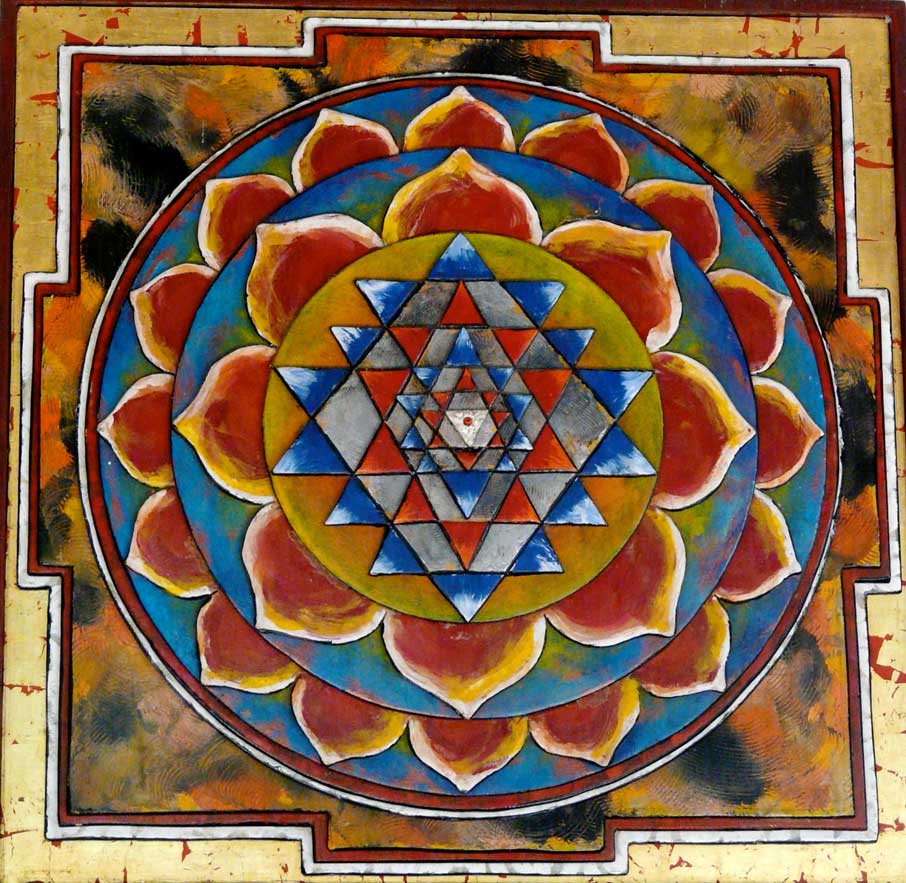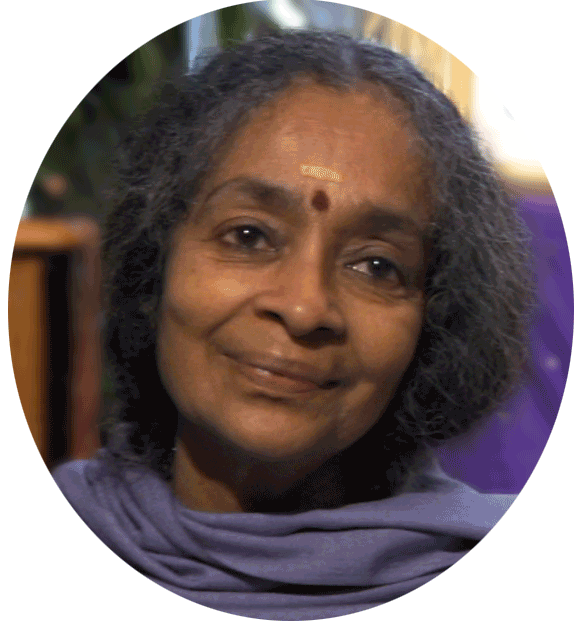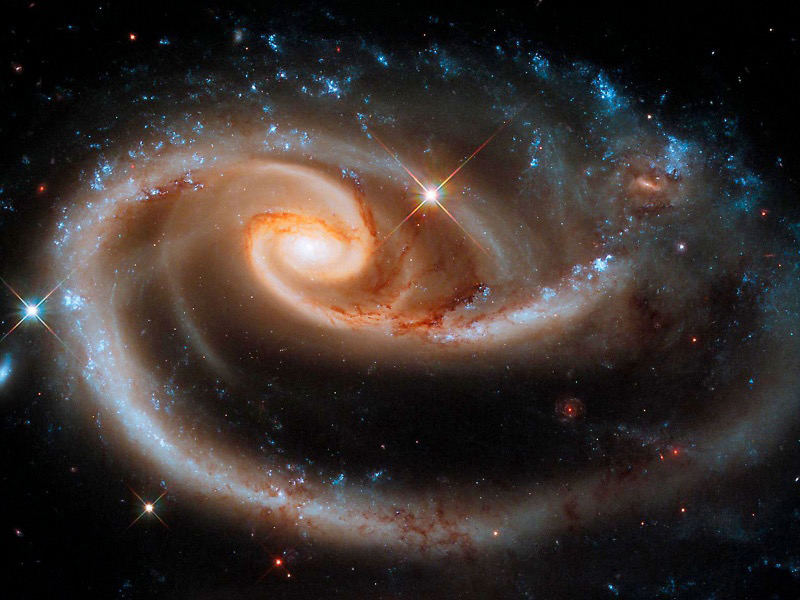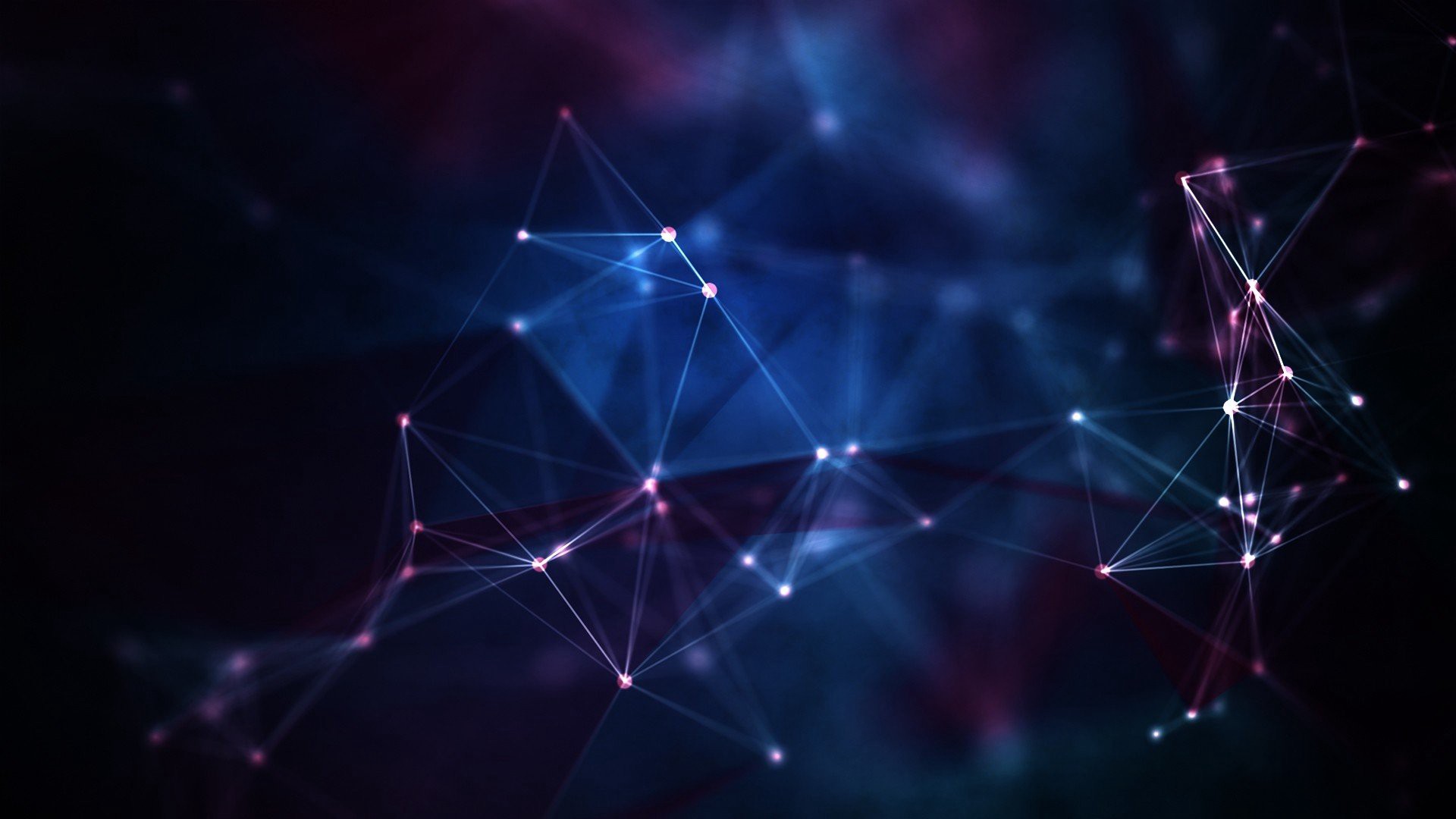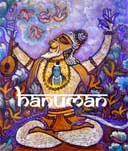Space
and time are closely connected as modern scientists have discovered
very recently. In fact Einstein even coined a new dimension called
Space/Time. We have already discussed the concept of Time in Hinduism.
So now let us look at the concept of Space. The idea of this planet
being the center of the solar system is something which our rishis dismissed
from the beginning. Many thousands of years ago they knew for sure that
the sun was the center of our solar system. How they found this out
without the use of modern instruments is still a mystery to the western
scientists but the fact is that rishis who
heard the vibrations of specific sounds in ether, memorized them into
the vast fund of knowledge called the Vedas. They had extremely
accurate, astronomical and heliocentric calculations for the movements
of both our Earth and other celestial bodies. The following is the
quotation from the Vedas.
“The
sun never sets or rises. When people think the sun is setting, he only
changes about after reaching the end of the day and makes night below
and day to what is on the other side. Then, when people think he rises
in the morning, he only shifts himself about after reaching the end of
the day night, and makes day below and night to what is on the other
side. In truth, he does not see at all.”
- Rig Veda. Brahmanas
“The
world is like a potter’s wheel: the wheel looks as if it stands
still, though it revolves at a terrific speed.”
- [1.27] Yoga Vasishta
They
realized that the orbits of all celestial bodies are elliptical. They
even noted the wobble of the Earth’s axis which creates the movement
called procession of the equinoxes which is a very slow movement which
completes one cycle every 25,920 years. This has been accommodated into
the Hindu calendar. This has only recently been validated by modern
science. Of course this is hardly noticed by civilizations which have
only existed for a couple of thousand years but it was a great
consideration for civilizations which have existed for millennia!
Just
as Hinduism believes in unbelievable cycles of Time and has calculated
Time to its smallest conceivable unit, it has also recorded the smallest
unit of space which is the atom.
The Bhagavat Purana describes an atom as “paramanu” and each “anu” (molecule) consisting of at least 2 paramanus.
To quote: “The
ultimate particle of the material universe is indivisible and not
formed into a body. It is called a paramanu. It exists as an invisible
entity even after the dissolution of all forms. All material bodies are
combinations of such paramanus.”
The Rig Veda says that paramanus are the ultimate state of the manifest universe. When they stay in their own forms they are called the Unlimited Oneness.
The Parama Mahan is subtler than the paramanu. The Parama Mahan is unique . It has no difference, no spacing and leaves nothing behind.
Time can be measured by the movement and combination of these particles.
Two paramanus can combine to form an anu and three combine to form a trasaranu. The rays of light emerging from a mesh can make these move up in empty space.
In
recent times it is the great scientist Kanada who wrote about atoms.
Acharya Kanada is known as the father of modern atom-ism. He founded the
Vaisheshika School of philosophy where he taught his ideas about the
atom and the nature of the universe. He wrote a book on his research
called the “Vaisheshika Darshan”
Kanada
claimed that every object of creation is made of atoms which in turn
connect with each others to form molecules. His theory of the atom was
abstract and enmeshed in philosophy as they were based on logic and not
on experimentation but modern science has corroborated his theories to a
large extent.
It
is said that one day while he was in the city of Dwaraka, Kanada was
walking with food in his hand, breaking it into small pieces. Suddenly
he realized that he was unable to divide the food into any further
parts. From this moment, Kanada conceptualized the idea of a particle
that could not be divided any further. He called that indivisible matter paramanu (atom). He even dissected the atom and called it an anu.
Acharya
Kanada proposed that this indivisible matter could not be sensed
through any human organ or seen by the naked eye, and that an inherent
urge made one paramanu combine with another. When two paramanusbelonging to one class of substance combined, a dwinuka (binary molecule) was the result. This dwinuka had properties similar to the two parent parmanus.
Kanada suggested that it was the different combinations of parmanus which
produced different types of substances. He also put forward the idea
that atoms could be combined in various ways to produce chemical changes
in presence of other factors such as heat. He gave blackening of an
earthen pot and ripening of fruit as examples of this phenomenon.
Western
civilization discovered Relativity and the atomic theory and used it
for the manufacture of atom bombs whereas the Hindu culture applied the
same knowledge to the development of new states of consciousness!
Unlike
the west which lives in a historical world bound by dates and time, the
Hindu culture is rooted in a timeless universe which is eternally
created and eternally destroyed. The rishis were
spiritual scientists who had gained an insight into the nature of
Reality through deep meditative and ascetic practices. Modern physics
requires experimental proof of their theories whereas the rishis wanted
experiential proof. Most important was that they did not want to use
their knowledge for material purposes but to find release (moksha) from the bonds of space and time.
They
were not concerned about using their vast knowledge to enhance the
quality of living in the way of modern conveniences for they knew that
adding to physical comforts was one of the lowest types of uses to which
they could put the enormous amount of knowledge which was at their
disposal. There were innumerable ways of applying it especially in the
realm of conducting experiments on themselves which would enable them to
enhance their inner states and take them to a state of bliss which is
what everybody is after but nobody seems to get. This is because we
think that our happiness can be enhanced by the accumulation of more and
more physical comforts and material goods and naturally this leads to
further and further disappointments. Nobody thinks of looking within
himself to find the source of bliss as well as of all knowledge. Our
gaze is totally outer oriented hence we flounder in the sea of
misconceptions clutching at comfortable straws to save ourselves or give
us fleeting moments of pleasure.
Not
only did the ancient Hindus know about the smallest bit of matter which
occupies space but they also knew of the extent of space and even
discovered the fact that space is expanding. (The concept of the
expanding universe is a very recent discovery in the West.)The earth is
only a small dot in the vast expanse of space which is expanding at an
inconceivable rate. In the cyclical order of creation, it happens that
every creation is preceded by destruction and followed by another
creation.
“After
a cycle of universal dissolution, the Supreme Being decides to recreate
the cosmos so that embodied souls can once again experience worlds of
shape and solidity. Very subtle atoms begin to combine, eventually
generating a cosmic wind that blows heavier and heavier atoms together.
Souls depending on their karma earned in previous world systems,
spontaneously draw to themselves atoms that coalesce into an appropriate
body.”
— The Prashasta Pada.
This was written a few thousand years ago!
The concept of parallel universes are also found in the Brahma Vaivarta Purana.
“And
who will search through the wide infinities of space to count the
universes side by side, each containing its Brahma, its Vishnu, and its
Shiva? Who can count the Indras in them all — those Indras side by side,
who reign at once in all the innumerable worlds; those others who
passed away before them; or even the Indras who succeed each other in
any given line, ascending to godly kingship, one by one, and, one by
one, passing away?”
- Brahma Vaivarta Purana
Thus
Hinduism has an unimaginable cosmological view of human beings having
existed for trillions of years and the fact that they will continue to
populate many universes in the future.
We
have seen how the Vedas and Puranas dealt with the smallest particles
of matter occupying space so now let us examine the Hindu idea of
infinite space. The Puranas vividly describe the fourteen parallel
realities which are co-existing and intersecting with us on multiple
levels. Of course modern science is still to discover this but
considering that the Hindus knew so much of our world which is only very
slowly being revealed to the west, we can safely say that their
descriptions of these worlds must also be real. Their astronomical
discoveries are extremely precise and agree with many of the results of
modern astronomy. Their culture and knowledge of astronomy baffles all
our present understanding which is actually only touching the fringes of
this colossal universe.
There
are several statements in the Vedic texts about the universe being
infinite. On the other hand it is to be noted that they do give the
exact, finite, distance to the sun! In the Vedas, Aditi is the mother of
the gods and she is actually a personification of the concept of
Infinity! The famous hymn “Purnamada, purnamidam, purnad purnamudachyate, purnasya, purnamadaya, purnamevavashishyate,” gives a wonderful description of Infinity.
It
means “That is infinite and this is infinite. If you take the
infinite from the infinite, Infinity alone will remain!”
Just
imagine how ancient this hymn is and then you will realise the extent
of their knowledge of the paradoxical properties of Infinity!
Another hymn from the Yajurveda refers
to the outer world as an altar made of bricks in which numbers are
given in multiples of ten that go up to ten hundred, thousand million.
Obviously their idea of space was infinite!
The
6th chapter called the “Creation of the Universe”, in the Satapata
Brahmana, speaks of the creation of the earth as having taken place
after the other stars. As usual abstractions were normally personified
in the Vedas and Puranas. Here Prajapati is the name given to the
creator and out of him come the various stars called, Ashva (Vivaswan),
Rishabha, Aja, Kurma which come before the creation of the earth.
Vivaswan of course refers to the sun while Rishabha (the twin asses),
refers to Gemini, Aja is Capricorn and Kurma, Cassiopeia.
The Puranas view the universe as having a diameter of about 500 million yojanas.
But beyond this universe lies the limitless Pradhana which has within
it, countless other universes! Many of our Puranas like the Vishnu
Purana, Srimad Bhagavata Purana, Padma Purana and Vayu Purana have
mentioned the different universes. This is a modern discovery of the
19th century western scientists.
The Vedas speak of three types of space- physical space, psychological space and the Infinite space of the super consciousness.
This Infinite space exists everywhere. It is that pure consciousness of
the Supreme Brahman which fills everything, inside and outside. The
word “Brha” means full. This is the background of everything which is in
us also and on which the play of our own limited space can work. This
limited psychological space of divided consciousness in us, is what
creates the divisions of Time and the separative ego. Physical space is
that in which the elements exist. Both these of course are dependent on
the Infinite space of Super Consciousness.
Every
atom of matter contains within itself a replica of the universe. In
fact every atom of every rock will contain infinite data about the
creation of the universe. Every molecule of air and every drop of water
contains a tiny universe. This is visible only to the seer and the sage
who can penetrate into the heart of a rock and discover its secrets. The
scientist on the other hand whose only tool is his penetrating
intellect tries to discover the secrets of the universe by the
devastating process of blasting and dissecting. He has to break open the
rock to discover its components. He has to tear open the petals of the
flower to discover its secret but in doing so he misses out the true
meaning of the universe which hides its secret in the heart of every
flower and every rock!
Actually
many of our ancient scriptures speak about the relativity of Time and
Space. We might be tricked into thinking that these are only flights of
imagination but when we see the conclusions of modern science we are
forced to believe that these ideas have come from a sophisticated
tradition of super cognitive and analytical thought. The recurring
question is of course how they managed to find all these facts without
the use of modern technology?
Till
very recently Western science tried to separate the investigator from
the object of investigation. They wanted the experiment to be totally
unbiased by the personal beliefs of the experimenter. The Hindu system
from the very beginning knew of the deep interconnection between the
observer and the observed. Direct experience was considered to be the
basis of all proof. The substratum was always the intelligence of the
observer which turns into the very act of observing and finally the
experience itself. Great names of quantum physicists like Schrodinger
and Moore have given credit to this method of experimenting. It was only
recently that the west understood that one could not totally divorce
the experimenter from the experiment.
Hindu
scriptures have delegated space into many ‘Lokas” or worlds just as
they have divided Time into many eons which are cyclic and go on
forever. Both Time and space are indestructible.
Fourteen lokas are described in Hinduism. There are 7 Vyarthis or upper worlds and 7 Patalas or lower worlds.
The highest of the Vyarthis is known as Satya Loka or the world of Brahma (the creator). Even though this is not eternal, those jivatmas who attain this loka will not have any re-birth.
2nd is Tapa- Loka which is the abode of some of the greater gods.
Then 3rd comes Jana-Loka which is the abode of the sons of the creator Brahma. The Prajapathis and others live here.
The 4th is Mahar Loka which is the abode of the great rishis and sages.
Fifth
is Swar Loka or Swarga, which corresponds to the Puranic idea of heaven
where the gods like Indra, Varuna and so on live. They are in charge of
the world. This is the space between our sun and the pole star. Most of
the lesser gods 330 million, and other celestial beings like Gandharvas
and Apsaras live here.
The
6th is Bhuvar Loka or Pitru Loka which comes into our atmosphere — the
space between the earth and the sun. This is inhabited by semi-divine
beings and the ancestors.
The
7th of course is our earth. This is inhabited by human beings and
animals. According to the Vishnu Purana the earth is only one of
thousands of inhabited worlds that can be found in the universe.
Next we come to the 7 Patalas or nether worlds.
The
one closest to our world is Atala Loka which is ruled by Bala, the son
of the demon architect Mayan who possesses magical powers.
The 2nd is Vitala Loka which is ruled by Hara, one of the forms of Shiva. He is attended by his ganas or host of goblins, and ghosts. Gold is prized in this world and those who worship gold will end up in this region.
The 3rd is Sutala Loka which is ruled by the pious asura king called Maha Bali. Lord Vishnu himself is supposed to have become the guardian of his gate!
The 4th is Talatala Loka which is the realm of the demon architect Mayan who is well versed in sorcery.
The
5th is Mahatala Loka which is abode of the Nagas or serpents who are
the sons of Kadru. All the fierce names to be found amongst snakes, like
Takshaka are to be found here.
The
6th is Rasatala Loka which is the abode of the demons who are mighty
and cruel. They are constantly at war with the gods in Swar Loka.
The
7th realm which is the lowest is known as Patala Loka which is the
abode of the Nagas or serpents. Serpents have always been considered in
Hinduism as having extra-sensory perception. They have no ears but they
are very close to the earth since their whole bodies slide over the
earth all the time so they are the first to know of any approaching
natural calamity like an earthquake or tsunami or any such thing. This
region is supposed to be as beautiful as Swarga or Heavan. The heavenly
sage Narada describes it thus.
“This
region is more opulent than the upper regions of the universe, which
include heaven. The life here is of pleasure, wealth and luxury, with no
distress. The demon architect Mayan has constructed palaces, temples,
houses, yards and hotels for foreigners, with jewels. The natural beauty
of Patala is said to surpass that of the upper realms. There is no
sunlight in the lower realms, but the darkness is dissipated by the
shining of the jewels that the residents of Patala wear. There is no old
age, no sweat, and no disease in Patala.”
According
to the Vishnu Purana “Naraka” or Hell is another extension of space
which lies below Patala. It is the realm where sinners are punished.
Many different types of Narakas are described in the Garuda Purana and
the Bhagavat Purana which give appropriate punishment to wrong doers.
But this is not the equivalent of Hell as found in Christianity and
Islam. Yama the King of Naraka is also Dharmaraja or the God of Justice.
It is only a temporary phase for the wrong doers in which they are
punished for a certain amount of time. As soon as they balance their punya and papa (merit and sin) they are given another chance to redeem themselves by taking birth in this world.
All
the worlds are only temporary places of stay. When the body falls and
dies on earth, the God of Death known as ‘Yama Dharma Raja’ — Yama, the
lord of justice, tallies the person’s good and bad deeds while on earth
and decides whether the jivatma goes to a heaven or a hell, for how long, and in what capacity. The jivatma acquires
a body appropriate to the world it enters. At the end of its time in
those worlds when its good and bad deeds have been neutralised, it
returns to the earth (reborn as a life form on the earth). It is only
from the earth, and only after a human life, that the jivatma can attain supreme salvation, the state that is free from the cycle of birth and death.
But
again and again we are brought back to the original concept of the
Infinite, Supreme Being who is totally unattached and in whom all these
different universes exist.
“The
countless universes, each enveloped in its shell, are compelled by the
wheel of time to wander within You, like particles of dust blowing about
in the sky.”
- Srimad Bhagavata Purana.
In
other words Time and Space are just concepts. In the state of the
Supreme neither of these exists. Therefore the insistence in Hinduism to
attain that state of bliss which is beyond the concepts of Time, Space
and Causality.
Aum Tat Sat
Shakti
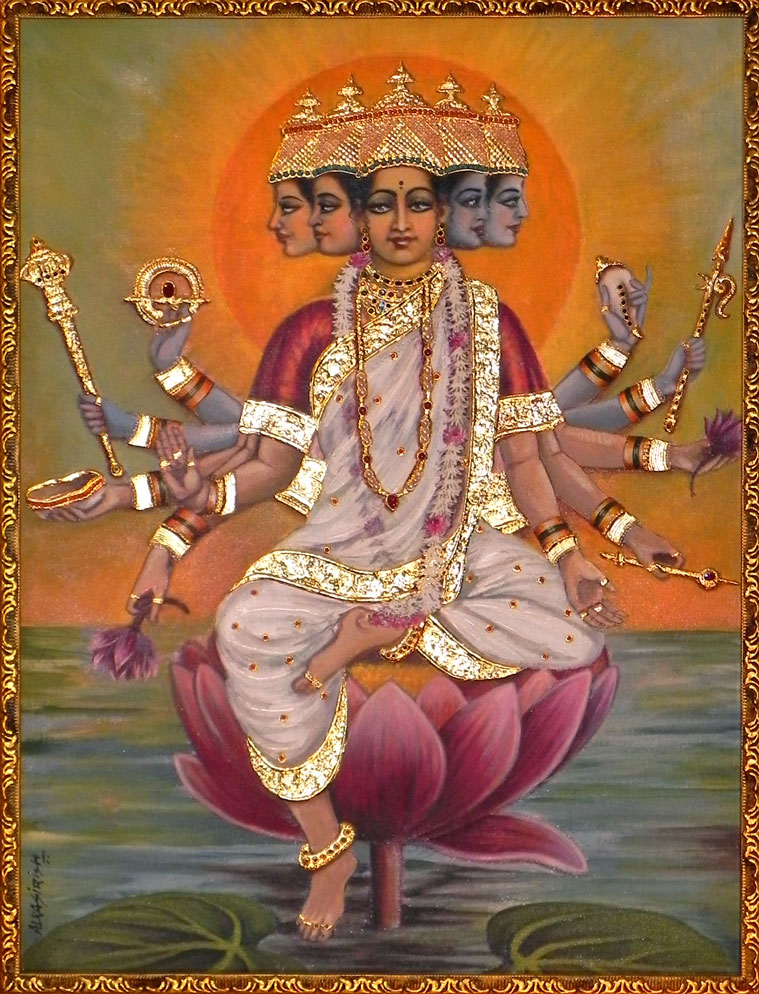
Shakti is the primeval force, the first emanation of power from the
Absolute — Brahman. She is the creative aspect of the Brahman. It is
through her that the One becomes the Many! She is the womb of the
universe.
Hinduism is famous for its symbolism and from ancient times the
pictorial representation of God took the form of both male and female.
The transcendental, formless and motionless Absolute came to be
associated with the male and its multi-formed, active, manifested
energy, with the female. This two- in-one existence came to be known
as Purusha and Prakriti or Shiva and Shakti. This union can be compared
to the dynamo and the force that charges it. The Purusha is inactive,
consciousness and Prakriti is unconscious action. In Hinduism time is
cyclic and one creation is followed by destruction and again another
creation and destruction. During the time of dissolution, Shakti lies
quiescent and is only a potential. But at the time of creation, Shakti
separates from Shiva and pierces the Bindu or point from which
everything expands with the sound of “Hreem” and creates this entire
paraphernalia of existence. (This is very much like the Big Bang theory
in which the cosmos explodes from a single point).
In
Hinduism, sound is a vibration of the Undifferentiated Intelligence of
the Brahman and acts as a catalyst which sets into motion the unfolding
of the manifest universe. This vibration is known as “Sabda
Brahman”- the Absolute as “sound”. It is a wavelength
that can be experienced only by the Divine.
This sound vibration splits Shakti into two opposite fields of magnetic
force called — “nada and bindu”. Bindu is the centrifugal, positive male
force and Nada the centripetal, negative, female force. Bindu is the
ground from which nada operates. It is nada which unfolds the manifest
universe. This duality of poles is the magnetic force that holds
together in a state of vibration all the molecules of the physical
world.
Shakti or energy is the physical ultimate of all matter as science has
proved. “Matter is only energy in motion”. All that we know and
experience with our mind and senses is nothing but the manifestation of
Shakti. The transcendental aspect of the Purusha is something which we can never know.
Hinduism has always extolled the superiority of the feminine principle
in all things concerning the physical world. With its ability to pictorise
everything, Shakti has been depicted as Goddesses in various forms.
Every male god is endowed with his own feminine Shakti. But the
interesting thing is that the name of the god is always preceded by the
name of his consort — Lakshmi/Narayana, Gauri/Shankara,
Radha/Krishna etc. Even in the normal names given to girls, the word,
Devi (goddess) used to be added. This is to say that originally Hinduism
encouraged everyone to look upon all women as personifications of the
Goddess.
This is the basis of the Shakti cult in which the divine is worshipped in
the form of Devi or the Divine Mother. Our relationship with our mother
is our primary relationship. Therefore all of us can have an instant
rapport with the Divine Mother since the mother is one with whom anyone
can have an intimate relationship. She is the eternal womb of all
creations, human, sub-human and animal. Wherever you see maternal love,
in a bird, or animal or human, know that to be but one spark of her
divine love, for she is the universal mother! The umbilical cord which
binds us to this Divine Mother is one which can never be broken. Our
dependence on her is absolute! Unfortunately the modern age seems to
have forgotten this basic truth, that we are totally dependent on her
for our very existence. We call her “dirt” and treat her
like dirt!! In
India she is venerated. The first thing we do in the morning when we
rise out of bed is to touch the ground and ask her to forgive us for the
transgressions done to her during the course of the
day — stamping her, digging her,
throwing garbage on her, spitting on her etc.
All
of us regardless of the religion we belong to, are followers of Shakti
since all of us long for power, beauty and wisdom. All these come from
her alone.
There
is another interesting aspect of Hinduism which is not to be found in
any other religion. It has always recognised that this world is one of
duality and since the universe is the projection of Shakti, she will
have many forms, both positive and negative. She is the source of beauty
and ugliness, wisdom and ignorance, happiness and unhappiness! Hindus
are encouraged not to just worship her beauteous form as Lakshmi, the
goddess of beauty and auspiciousness but to worship her in her hideous
form as Kali, the destroyer. Not just to worship her as Saraswati, the giver of all wisdom and art, but also to worship her as
Mahishasuramardini, the destroyer of evil and Chandika, the terrible,
whose wrath lets loose the typhoon, the flood and the tsunami! This
recognition that all things both positive and negative stem from one
source is unique to Hinduism. The One God of Hinduism is an all-
inclusive, transcendental as well as immanent God from which nothing
is left out and therefore nothing is condemned. He is available to
everyone regardless of whether one believes in him or not. The One God
of the Semitic religions is a transcendental and exclusive
God-exclusively belonging to those who believe in him! Those who don’t
believe in him are condemned as heretics, bound to go to hell!
Hinduism
believes Shakti to be Maya, the enchantress who has bound us to this
enthralling universe with bonds of love. Since she is the one who has
bound us she is also the one who can release us. By her grace alone can
we be released from the darkness of ignorance, the bondage of maya and
taken to the abode of bliss. Thus two, nine-day periods are set aside
during the course of the year, exclusively for her worship. This is
known a “Navaratra.”
Hari Aum Tat Sat
DAKSHINAAYANAM
The Southern Path
Time is a convenient concept devised by the human mind as an aid to
life. In Hinduism time is cyclical and entirely based on the rotation of
the earth on its axis and its revolution round the sun. Since
everything goes in circles, time also has to go in circles. Day is
followed by night and night by day, Sunday is followed by Monday and so
on till another Sunday and January is followed by February and so on
till we come to the end of one year. It is all cyclical.
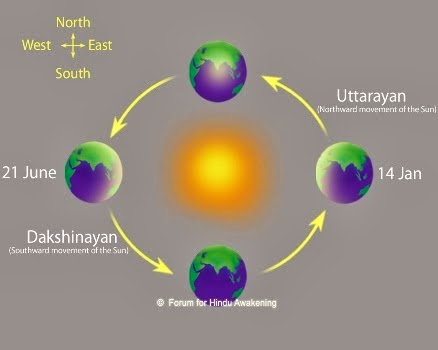
The
Hindu calendar divides the year into two halves of six months each
known as Uttarayanam and Dakshinayanam. The period from January 14th to
July 14th is known as Uttarayanam, the northern Path, (uttara is north
and ayanam is path). This is the time when the sun travels from
the Tropic of Capricorn towards the Tropic of Cancer. The period from
July 14th to January 14th is known as Dakshinayanam or the Southern Path
(dakshina is south and ayanam is path). Obviously the paths we are
referring to is the path of the sun which “seems” to be
moving from north to south and back again. Of course the whole thing is
an illusion created by the rotation of the earth round the sun. The sun
neither rotates nor changes. We are always taught that the sun rises in
the east and sets in the west and that at noon it will be right over our
heads. Actually the sun always rises slightly to the north during
Uttarayanam and slowly moves towards the south during Dakshinayanam. So
it’s always rising either north-east or south-east, never due
east. Only those who are living exactly on the Tropic of Cancer or those
who live less than 23.5 degrees above or below the equator can have the
experience of the sun directly overhead at noon. This happens during
the summer solstice on June 21st and winter solstice on 21st December.
We
have almost come to the end of Uttarayanam in this year 2018 and the
sun has reached the farthest limit of its journey to the north. These
movements are of great importance to those who live in the northern
hemisphere because all the countries in this hemisphere have passed
through winter and have been enjoying the seasons known as spring and
summer.
This
year the sun will start its journey to the south on the 16th of July,
heralding the start of Dakshinayanam. This is known as Karkata Sankranti
and marks the journey of the sun into the Karkata Rasi or Cancer. The
small changes in the dates are caused by the fact that Hindus follow the
lunar month of twenty-eight days. Those of you, who are used to
observing the path of the sun and watching sunrises and sunsets daily,
will notice that there is a dramatic change of direction from this day
onwards and bedrooms facing the south will start getting warmer. Hence
it is said that in the northern hemisphere it is always wise to have
south facing windows since they capture the last rays of the sun in
winter and thus ensure that the room is warm in winter and cool in
summer. In these six months of Dakshinayanam, the northern hemisphere
goes through the three seasons of monsoon, autumn and winter. This will
end on January 14th which is known as Makara Sankranti or the period of
the sun’s change from Cancer to Capricorn which heralds the coming
of Uttarayanam.
It
is only when we start perceiving all these natural changes of the solar
system that we realise that we are truly a solar-powered planet.
Literally speaking our whole life revolves round the sun! In the mad
rush of modern life it is really sad that we don’t realise this
supremely important fact. Whether we realise this or not the fact is
that we undergo many physical and emotional changes during these yearly
changes of the year and seasons. The most important change is that In
Dakshinayanam our planet starts to move in an anti-clockwise direction.
This is bound to have a definite impact on our internal systems which as
I said is solar powered.
As
usual the Hindu Puranas are filled with stories that cloak great
scientific truths. So it is said that Uttarayanam is the day of the gods
and Dakshinayanam is their night. So now we are slowly going towards
the night of the gods. It is a well known fact that time appears to go
faster as our consciousness increases. One day is a long period to a
child whereas even one year seems to spin by when we get older. The gods
who are in a state of very high consciousness have a different
reckoning of time. One human year is only one day for them. So
Uttarayanam is their day and Dakshinayanam their night. Uttarayanam is
considered to be an auspicious period since the gods are awake and
watching and ready to shower their blessings and Dakshinayanam,
inauspicious for conducting certain propitious events like marriages,
house warming etc since the gods are sleeping.
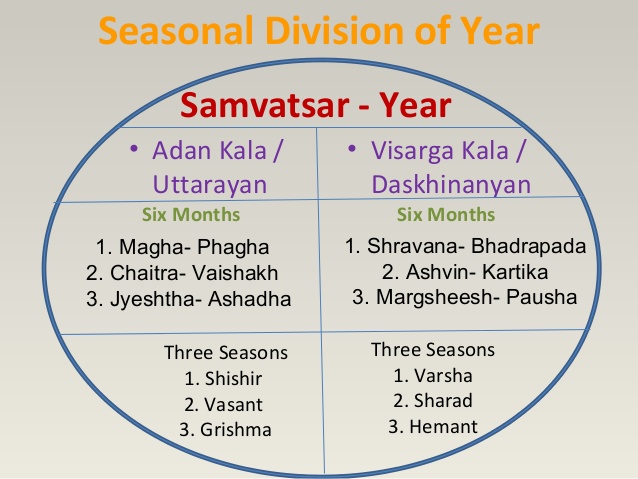
In
the first four months of Dakshinayanam it is advised not to conduct
marriages or important functions. These months are to be kept aside for
recouping all the spiritual energy we have lost during Uttarayanam which
is the time for us to involve ourselves in material types of work.
Marriages that take place during this period have more chances of
divorce and may even prove to be infertile.
However
these four months are most productive as far as any type of spiritual
pursuits are concerned. Practice of meditation, yoga, pranayama and any
type of advanced spiritual practices will have every chance of success
during this period. In olden days true sannyasis were wandering
ascetics. They were forbidden from staying in one place for more than a
few days. This was to stop them from forming attachments to any one
place or persons. The only time they were allowed to stay put in a place
was during the course of these four months known as Chaturmasya which
begin on July 11th and end on November 6th. During this period it was
their duty to teach the householders all that they had learnt during
their travels as well as to brush up on their reading of the Vedas and
other scriptures.
A
certain type of imbalance is created in our physical and mental systems
during these six months, caused by the anti clockwise motion of our
planet. In order to ward off the negativity thus created our scriptures
have decreed that these months are best suited for conducting all types
of rituals, yagas, pujas, fasts and festivals. The first month of
Dakshinayanam is known as Shravana in which we will feel a certain
amount of unevenness in the element of air in our system. This creates
emotional imbalance. In order to offset this emotional imbalance which
might lead to depression we find that many of our major festivals are
conducted during this season.
The
first full moon day in the month of Shravana (July/August) is
celebrated as Guru Purnima or Vyasa Purnima since it is the auspicious
day on which the great sage Vyasa was born and he is considered as the
very first Guru. So even in this practice of keeping aside special days
for mothers, fathers, brothers, sisters etc the Hindus were the first
for they had a special day for Gurus or spiritual teachers long before
“Mother’s day and Father’s day” were conceived
of !!
In the second month of Dakshinayanam known as Bhadrapada we celebrate
two of our most important festivals – Ganesha Chaturthi which is
dedicated to the Lord Ganesha and Janmashtami which celebrates the birth
of Lord Krishna. In the third month of Dakshinayana known as Ashwin we
celebrate the famous nine day festival to Durga known as Navaratri and
of course the even more important festival called Diwali.
Dakshinayanam
is best for doing any type of spiritual sadhana (spiritual practice)
and hence it is known as sadhana pada. All types of meditation, yoga,
pranayama or anything which is conducive to our spiritual evolution is
best practiced during this period. So everyone, whether, they belong to
the yogic system or not, should try and spend some time in spiritual
pursuits since it will yield maximum benefits.
There are seven chakras or centres of great power in our system that
controls all our physical, psychic and spiritual energies. They are not
physical entities but massive whorls of psychic energy that control our
body, mind and emotions. They lie along the spine. Muladhara chakra is
the spiritual centre that lies just above the anus, Swadhishtana is the
one between the anus and the genitals, Manipuraka corresponds to the
navel, Anahata lies next to the heart, Vishuddhi at the base of the
throat and Ajna at the meeting point of the two brows. Above the top of
the head is the Sahasrara chakra which is way beyond ordinary human
reach. The three chakras from the Mooladhara to the Anahata are all
meant for survival. Those above the Anahata are the ones that open up
our possibilities for spiritual expansion leading to enlightenment. In
chakra language, during the period of Dakshinayanam the journey of the
mind is from the Mooladhara to the Anahata chakras and in Uttarayana the
journey is from the Anahata to the Ajna. What this means to the
spiritual seeker and indeed to anyone who is interested in getting to
the topmost rung of spirituality, is that we should combine all the
forces that we have and concentrate on performing severe austerities
during this period of Dakshinayanam. After our intense sadhana for six
months we will be ready to accept the liberation that will come easily
to us during the next six months of Uttarayanam.
Despite
the minute as well as gargantuan calculations made by the Hindus, we
still believe that Time is only a mental concept. It exists only so long
as we are bound to the things of this world through our senses. It is a
concept created by the movement of our senses, the celestial bodies and
our own perceptions. It is part of the illusion in which we live and
which we take for real. In the consciousness of the Supreme Being there
are no divisions of Time. There is only the present moment, one
continuous, indivisible and indistinguishable state of existence.
Hari Aum Tat Sat
